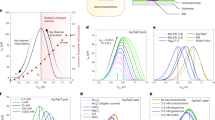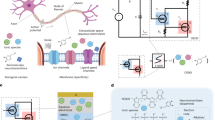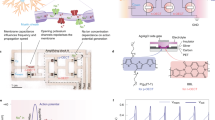Abstract
Significant advances have been made in the understanding of the pathophysiology, molecular targets and therapies for the treatment of a variety of nervous-system disorders. Particular therapies involve electrical sensing and stimulation of neural activity1,2,3,4, and significant effort has therefore been devoted to the refinement of neural electrodes5,6,7,8. However, direct electrical interfacing suffers from some inherent problems, such as the inability to discriminate amongst cell types. Thus, there is a need for novel devices to specifically interface nerve cells. Here, we demonstrate an organic electronic device capable of precisely delivering neurotransmitters in vitro and in vivo. In converting electronic addressing into delivery of neurotransmitters, the device mimics the nerve synapse. Using the peripheral auditory system, we show that out of a diverse population of cells, the device can selectively stimulate nerve cells responding to a specific neurotransmitter. This is achieved by precise electronic control of electrophoretic migration through a polymer film. This mechanism provides several sought-after features for regulation of cell signalling: exact dosage determination through electrochemical relationships, minimally disruptive delivery due to lack of fluid flow, and on–off switching. This technology has great potential as a therapeutic platform and could help accelerate the development of therapeutic strategies for nervous-system disorders.
This is a preview of subscription content, access via your institution
Access options
Subscribe to this journal
Receive 12 print issues and online access
$259.00 per year
only $21.58 per issue
Buy this article
- Purchase on Springer Link
- Instant access to full article PDF
Prices may be subject to local taxes which are calculated during checkout




Similar content being viewed by others
References
Wilson, B. S. et al. Better speech recognition with cochlear implants. Nature 352, 236–238 (1991).
Kumar, R. et al. Double-blind evaluation of subthalamic nucleus deep brain stimulation in advanced Parkinson’s disease. Neurology 51, 850–855 (1998).
Mayberg, H. et al. Deep brain stimulation for treatment-resistant depression. Neuron 45, 651–660 (2005).
Hochberg, L. R. et al. Neuronal ensemble control of prosthetic devices by a human with tetraplegia. Nature 442, 164–171 (2006).
George, P. et al. Fabrication and biocompatibility of polypyrrole implants suitable for neural prosthetics. Biomaterials 26, 3511–3519 (2005).
Williams, J. C., Holecko, M. M., Massia, S. P., Rousche, P. & Kipke, D. R. Multi-site incorporation of bioactive matrices into MEMS-based neural probes. J. Neural Eng. 2, L23–L28 (2005).
Richardson-Burns, S. et al. Polymerization of the conducting polymer poly(3,4-ethylenedioxythiophene) (PEDOT) around living neural cells. Biomaterials 28, 1539–1552 (2007).
Green, R., Lovell, N., Wallace, G. & Poolewarren, L. Conducting polymers for neural interfaces: Challenges in developing an effective long-term implant. Biomaterials 29, 3393–3399 (2008).
Abhyankar, V., Lokuta, M., Huttenlocher, A. & Beebe, D. Characterization of a membrane-based gradient generator for use in cell-signalling studies. Lab Chip 6, 389–393 (2006).
Guimard, N., Gomez, N. & Schmidt, C. Conducting polymers in biomedical engineering. Prog. Polym. Sci. 32, 876–921 (2007).
Hendricks, J., Chikar, J., Crumling, M., Raphael, Y. & Martin, D. Localized cell and drug delivery for auditory prostheses. Hear. Res. 242, 117–131 (2008).
Xu, H., Wang, C., Wang, C., Zoval, J. & Madou, M. Polymer actuator valves toward controlled drug delivery application. Biosens. Bioelectron. 21, 2094–2099 (2006).
Zinger, B. & Miller, L. L. Timed release of chemicals from polypyrrole films. J. Am. Chem. Soc. 106, 6861–6863 (1984).
Pernaut, J. & Reynolds, J. R. Use of conducting electroactive polymers for drug delivery and sensing of bioactive molecules. A redox chemistry approach. J. Phys. Chem. B 104, 4080–4090 (2000).
Abidian, M. R., Kim, D. & Martin, D. C. Conducting-polymer nanotubes for controlled drug release. Adv. Mater. 18, 405–409 (2006).
Pei, Q. & Inganaes, O. Electrochemical applications of the bending beam method. 1. Mass transport and volume changes in polypyrrole during redox. J. Phys. Chem. 96, 10507–10514 (1992).
Wang, X., Shapiro, B. & Smela, E. Visualizing ion currents in conjugated polymers. Adv. Mater. 16, 1605–1609 (2004).
Isaksson, J. et al. Electronic control of Ca2+ signalling in neuronal cells using an organic electronic ion pump. Nature Mater. 6, 673–679 (2007).
Chiang, C. et al. Electrical conductivity in doped polyacetylene. Phys. Rev. Lett. 39, 1098–1101 (1977).
Heywang, G. & Jonas, F. Poly(alkylenedioxythiophene)s—new, very stable conducting polymers. Adv. Mater. 4, 116–118 (1992).
Groenendaal, L., Jonas, F., Freitag, D., Pielartzik, H. & Reynolds, J. R. Poly(3,4-ethylenedioxythiophene) and its derivatives: Past, present, and future. Adv. Mater. 12, 481–494 (2000).
Zhu, Z. et al. A simple poly(3,4-ethylene dioxythiophene)/poly(styrene sulfonic acid) transistor for glucose sensing at neutral pH. Chem. Commun. 1556–1557 (2004).
Isaksson, J. et al. Electronically controlled pH gradients and proton oscillations. Org. Electron. 9, 303–309 (2008).
Riedel, G., Platta, B. & Micheau, J. Glutamate receptor function in learning and memory. Behav. Brain Res. 140, 1–47 (2003).
Cryan, J. & Kaupmann, K. Don’t worry ‘B’ happy!: A role for GABAB receptors in anxiety and depression. Trends Pharmacol. Sci. 26, 36–43 (2005).
Meldrum, B. S. Glutamate as a neurotransmitter in the brain: Review of physiology and pathology 1. J. Nutr. 130, 1007S–1015S (2000).
Sontheimer, H., Kettenmann, H., Backus, K. H. & Schachner, M. Glutamate opens Na+/K+ channels in cultured astrocytes. Glia 1, 328–336 (1988).
Usowicz, M. M., Gallo, V. & Cull-Candy, S. G. Multiple conductance channels in type-2 cerebellar astrocytes activated by excitatory amino acids. Nature 339, 380–383 (1989).
Glaum, S. R., Holzwarth, J. A. & Miller, R. J. Glutamate receptors activate Ca2+ mobilization and Ca2+ influx into astrocytes. Proc. Natl Acad. Sci. USA 87, 3454–3458 (1990).
Purves, D. (ed.) Neuroscience 4th edn 283–314 (Sinauer, 2004).
Pujol, R., Lenoir, M., Robertson, D., Eybalin, M. & Johnstone, B. Kainic acid selectively alters auditory dendrites connected with cochlear inner hair cells. Hear. Res. 18, 145–151 (1985).
Duan, M., Agerman, K., Ernfors, P. & Canlon, B. Complementary roles of neurotrophin 3 and a N-methyl-d-aspartate antagonist in the protection of noise and aminoglycoside-induced ototoxicity. Proc. Natl Acad. Sci. USA 97, 7597–7602 (2000).
Bianchi, L. & Raz, Y. Methods for providing therapeutic agents to treat damaged spiral ganglion neurons. Curr. Drug Targets: CNS Neurol. Disord. 3, 195–199 (2004).
Ohyama, K., Salt, A. & Thalmann, R. Volume flow rate of perilymph in the guinea-pig cochlea. Hear. Res. 35, 119–129 (1988).
Dobrenis, K. Microglia in cell culture and in transplantation therapy for central nervous system disease. Methods 16, 320–344 (1998).
Acknowledgements
We wish to thank S. Plantman for providing primary astrocyte cultures, J. Kehr for access to the HPLC equipment, A. Viberg for technical assistance and D. Nilsson, P. Kjäll and T. Nakagawa for valuable discussion. This project has been carried out within the Strategic Research Center for Organic Bioelectronics (OBOE, www.oboe.nu) funded by the Swedish Foundation for Strategic Research (SSF). The Organic Electronics Group at Linköping University in Norrköping is a member of the COE@COIN project, also funded by the SSF. B.C. is supported by the Swedish Research Council, Funds of Karolinska Institutet and Tysta Skolan. The agencies that have supported this study were not involved in the design, interpretation, analysis or review of the data.
Author information
Authors and Affiliations
Contributions
D.T.S. was responsible for the design, characterization and operation of the encapsulated device, and primary preparation of the manuscript. S.K. characterized the planar devices and K.C.L. carried out in vitro cell experiments and assisted with operation of the devices in vivo. R.H. and B.C. carried out the surgical procedure and subsequent audiological and physiological analysis. K.T. manufactured the planar devices, M.G. carried out HPLC analysis and both K.T. and E.W.H.J. aided in the design of the encapsulated device. M.B., B.C. and A.R.-D. are the senior authors of the paper. Each was responsible for supervision in their respective departments, as well as project planning and preparation of the manuscript.
Corresponding authors
Supplementary information
Supplementary Information
Supplementary Information (PDF 1080 kb)
Rights and permissions
About this article
Cite this article
Simon, D., Kurup, S., Larsson, K. et al. Organic electronics for precise delivery of neurotransmitters to modulate mammalian sensory function. Nature Mater 8, 742–746 (2009). https://doi.org/10.1038/nmat2494
Received:
Accepted:
Published:
Issue Date:
DOI: https://doi.org/10.1038/nmat2494
This article is cited by
-
Recent developments in multifunctional neural probes for simultaneous neural recording and modulation
Microsystems & Nanoengineering (2023)
-
Bionic iontronics based on nano-confined structures
Nano Research (2023)
-
Hydrogels: potential aid in tissue engineering—a review
Polymer Bulletin (2022)
-
A digital nervous system aiming toward personalized IoT healthcare
Scientific Reports (2021)
-
On-chip ionic current sensor
Applied Physics A (2021)



